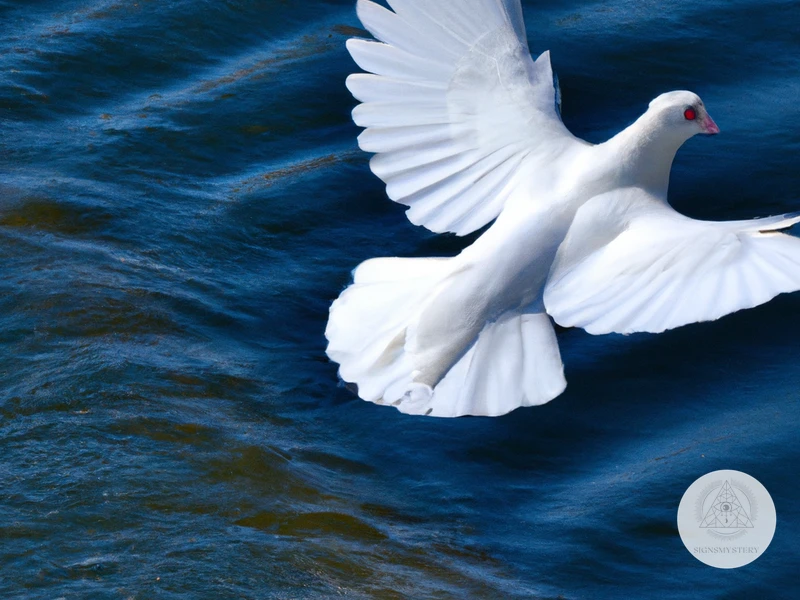The Holy Spirit is one of the most important elements of Christianity. It is considered to be the third person of the Holy Trinity, alongside the Father and the Son. Throughout history, the Holy Spirit has been symbolized in many different ways, but none as prominent as the dove. The dove is a universal symbol of love, peace, hope, and purity, making it an apt representation of the Holy Spirit. In this article, we will explore the significance of the Holy Spirit dove symbol in Christianity, both in the Bible and in Christian art and literature. We will also examine the various interpretations of the symbol and what it represents to different Christians around the world.
The Dove Symbol in the Bible

The dove symbol is an important biblical motif that represents various aspects of the Christian faith. The dove first appears in the Old Testament book of Genesis, where it is sent by Noah from the Ark to search for dry land. In the New Testament, the dove appears during Jesus’ baptism, when the Holy Spirit descends upon him in the form of a dove, signifying divine approval. This event is referenced in all four of the Gospels and is seen as a pivotal moment in Jesus’ ministry. The dove symbolizes purity, peace, and innocence, and is often used in Christian art and literature to represent the Holy Spirit. Its presence in the Bible provides rich imagery for Christians to contemplate and draw inspiration from, as they seek to deepen their understanding of God and their faith.
Old Testament References
The Holy Spirit Dove Symbol has its roots in the Old Testament. It was first mentioned in the book of Genesis, during the story of Noah’s Ark. After the flood, Noah sent out a dove to find dry land. The dove returned with an olive branch, signaling the end of the flood and a new beginning for humanity. This story represents the Holy Spirit bringing hope and new life to the world after a time of judgment.
Another Old Testament reference can be found in the book of Isaiah. The prophet Isaiah speaks of the coming of the Messiah and the Spirit of the Lord resting upon him like a dove. It says, “The Spirit of the Lord will rest on him – the Spirit of wisdom and of understanding, the Spirit of counsel and of might, the Spirit of the knowledge and fear of the Lord” (Isaiah 11:2).
Similarly, in the book of Psalms, it says, “I will take refuge in the shadow of your wings until the disaster has passed” (Psalm 57:1). This image of taking refuge in the shadow of God’s wings is often associated with the Holy Spirit Dove Symbol, representing the comfort and protection that the Holy Spirit provides.
These Old Testament references set the foundation for the Holy Spirit Dove Symbol in Christianity. As the symbol evolved throughout history, it gained deeper meanings and interpretations but its origins can be traced back to these early biblical stories.
New Testament References
In the New Testament, the dove symbol appears during significant events in the life of Jesus Christ. Matthew 3:16 describes the dove descending from heaven during Jesus’ baptism, symbolizing the descent of the Holy Spirit upon him. This event marks the beginning of Jesus’ ministry on Earth, and the presence of the Holy Spirit empowers Jesus to carry out his mission.
Another significant occurrence of the dove symbol in the New Testament can be found in John 1:32-34, where John the Baptist testifies to seeing the Holy Spirit descend like a dove upon Jesus during his baptism. John also identifies Jesus as the Lamb of God, emphasizing the purity, sacrifice, and redemption that Jesus brings to humanity through his death and resurrection.
In John 20:19-23, the Holy Spirit appears to the disciples in the form of a dove after Jesus’ resurrection, bringing them peace and empowering them to spread the good news of the gospel to the world.
The dove symbol in the New Testament emphasizes the power and presence of the Holy Spirit in the work of redemption and salvation. It serves as a reminder to Christians of the importance of embracing the Spirit’s guidance and empowerment in their lives and in the spread of the gospel message.
Internal Link: To understand more about the symbolism of the cross in Christianity, read our article about the cross symbol in Christianity.
The Holy Spirit Dove Symbol in Christian Art and Literature
The Holy Spirit Dove Symbol has been a prevalent motif in Christian art and literature for centuries. In Christian iconography, the dove represents the Holy Spirit’s manifestation as a gentle and pure spirit. Early Christian art often depicted the Holy Spirit as a dove, such as in the catacombs of Rome. During the Renaissance, the dove symbol was used heavily in Christian art, ranging from paintings to sculpture, with Raphael’s depiction of the Holy Spirit as a dove in “The Baptism of Christ” being a famous example. Contemporary art has also made use of the Holy Spirit Dove Symbol, as artists continue to draw inspiration from religious themes and imagery. The Holy Spirit Dove Symbol has remained an important aspect of Christian art and serves as a reminder of the Holy Spirit’s presence in the world.
Early Christian Art
During the early Christian period, the dove symbol was primarily used to depict the Holy Spirit. In Christian art, the dove was often shown with a halo or rays of light shining down on it to represent holiness and divinity. The use of the dove in Christian art during this period was heavily influenced by classical art.
Many early depictions of the dove in Christian art showed it holding an olive branch in its beak, symbolizing peace and hope. In early mosaics, the dove is also seen alongside other symbols of Christianity such as the anchor and the fish symbol, which represented hope and faith respectively. The dove was also used to represent the baptism of Jesus, as it was said that the Holy Spirit descended upon him like a dove.
One of the earliest surviving depictions of the Holy Spirit as a dove can be seen in the Catacombs of Domitilla in Rome, which dates back to the 4th century. In this artwork, the dove is shown descending from heaven towards a group of apostles, representing the Holy Spirit’s descent upon them during the Pentecost.
Another important artwork from the early Christian period that features the dove symbol is the apse mosaic in the Basilica of San Clemente in Rome. In this artwork, the dove is seen alongside other symbols of the Holy Trinity such as the Alpha and Omega and the cross.
The early Christian period saw the dove symbol being used prominently in Christian art to represent the Holy Spirit and various other Christian concepts. The use of the dove in Christian art has continued to evolve and adapt over time, but it remains an important symbol within the Christian faith.
The Renaissance
During the Renaissance, the Holy Spirit Dove symbol experienced a resurgence in popularity in Christian art. The period was marked by an increased interest in classical art, which led to the development of more realistic representations of the Dove in art. In some cases, the Dove was depicted as a highly-detailed feathered bird, imbued with a sense of movement and life.
One of the most famous art pieces featuring the Holy Spirit Dove is the painting “The Annunciation” by the Renaissance artist Fra Angelico. In the painting, the Dove is shown descending towards the Virgin Mary, who is reading. The painting captures the wonder and beauty of the moment and is considered one of the most iconic representations of the Holy Spirit Dove.
Another popular theme during the Renaissance was the depiction of the Holy Trinity – God the Father, Jesus Christ, and the Holy Spirit – with the Dove symbolizing the Holy Spirit. Examples of this can be seen in works such as “The Trinity” by the artist Masaccio.
The Renaissance period allowed for a greater emphasis on the beauty and realism of the Holy Spirit Dove symbol. This helped to solidify its place in Christian art and culture, further emphasizing its importance alongside other powerful Christian symbols such as the Ichthus or Alpha and Omega symbols.
Contemporary Art
Contemporary Art: The symbolism of the Holy Spirit Dove continues to be a popular motif in contemporary Christian art. One example is the “Dove of Peace” mosaic on the West Front of Westminster Abbey in London, England. This mosaic was created in 1998 by artist Boris Anrep and depicts the Holy Spirit Dove flying over Jesus Christ. The image is made up of thousands of tiny colored glass pieces. Another example is the “Dove of Hope” sculpture by artist Timothy Schmalz, which features a dove in flight, with its wings spread wide. This sculpture is designed to evoke feelings of hope and inspiration in the viewer.
Contemporary Christian art also uses the Holy Spirit Dove symbol in more abstract ways. For example, the artist Makoto Fujimura created a series of paintings called “Charis” that use gold leaf and other materials to create a shimmering, ethereal effect. One of the paintings in the series, called “Charis: Rain,” depicts a white dove in flight against a gold background, symbolizing the Holy Spirit descending from heaven.
There are also many contemporary Christian jewelry and gift items that feature the Holy Spirit Dove symbol, including necklaces, bracelets, and wall art. These items are often given as gifts to celebrate religious milestones such as baptisms and confirmations.
The Holy Spirit Dove symbol continues to be a meaningful and powerful representation of the Christian faith in contemporary art and culture. Whether depicted in traditional ways or in more abstract forms, the Holy Spirit Dove remains a symbol of purity, peace, and hope for Christians around the world.
Interpretations of the Symbol
The Holy Spirit Dove symbol has various interpretations in Christianity, each significant in its own right. The most common interpretations includes purity and innocence, peace and hope, and the Holy Trinity. Purity and Innocence – the dove is known for its gentle and pure nature, and it is a common belief that the symbol represents the peaceful and immaculate attributes of the Holy Spirit. Peace
Subscribe to Our Newsletter
Sign up to receive the latest news and updates.
Purity and Innocence
The dove has long been associated with the virtues of purity and innocence in the Christian faith, with its white feathers serving as a visual reminder of these qualities. In fact, in the Bible, when Noah sends a dove out from his ark, it returns to him with an olive branch, symbolizing the end of the floods and the coming of peace.
The association between the Holy Spirit dove and purity is also seen in Christian art. For example, in the painting, “The Baptism of Christ,” by Piero della Francesca, the Holy Spirit dove, hovering above Jesus, symbolizes the purity of Christ and the purity that baptism brings.
The Holy Spirit dove can be seen as a representation of the purity of the human soul. Just as the dove is seen as a blameless and pure animal, so too can humans strive towards purity and innocence through the guidance of the Holy Spirit.
The Holy Spirit dove serves as a powerful symbol of purity and innocence in the Christian faith, reminding believers to strive towards these virtues in their daily lives, just as the dove symbolizes peace and hope.
Peace and Hope
The dove symbol of the Holy Spirit is often associated with the idea of peace and hope in Christianity. In the New Testament, when John the Baptist baptized Jesus, the Holy Spirit descended upon him in the form of a dove. This event is considered a sign of peace and hope because it marked the beginning of Jesus’ public ministry, which brought the message of God’s love and forgiveness to humanity.
The dove symbol has been used in Christian art and literature to represent these concepts. In paintings and sculptures, a dove holding an olive branch is often seen as a symbol of peace. The olive branch represents peace and reconciliation, and the dove symbolizes the Holy Spirit bringing those things to the world.
Hope is also closely associated with the dove symbol because of its connection to the story of Noah’s Ark in the Old Testament. After the great flood, Noah sent out a dove to look for dry land. The dove eventually returned with an olive branch, indicating that the waters had receded and the earth was beginning to recover. The dove with an olive branch thus became a symbol of hope for humanity, that even in the darkest times, there is always the possibility of renewal and new beginnings.
Many Christians believe that the Holy Spirit brings peace and hope to their lives and to the world. The dove symbol is a powerful reminder of this belief, and it is often used in Christian art and literature to convey a message of hope and peace. Whether seen in ancient mosaics or modern paintings, the Holy Spirit dove symbol continues to inspire and uplift people of all faiths.
The Holy Trinity
One of the most significant meanings of the Holy Spirit dove in Christianity is its representation of the Holy Trinity. The Holy Trinity refers to the Christian belief in the three distinct persons within the one Godhead: Father, Son, and Holy Spirit. This doctrine is central to the Christian faith and is a fundamental aspect of their belief system.
In Christian art, the Holy Spirit dove is often depicted alongside the image of Jesus Christ and God the Father, symbolizing the unity of the three persons of the Holy Trinity. This image can be seen in numerous pieces of artwork around the world, from ancient times to contemporary art.
The Holy Spirit dove in this context represents the Holy Spirit as the third person of the Trinity, who is sent by the Father and the Son to guide and empower Christians. The Holy Spirit is often depicted as hovering over or descending upon Jesus at significant moments in the Bible, such as during his baptism and after his ascension to heaven.
The Holy Trinity doctrine can be found throughout the Bible, with numerous references to the Father, Son, and Holy Spirit. For example, in Matthew 28:19, Jesus instructs his disciples to baptize in the name of the Father, Son, and Holy Spirit. Similarly, in 2 Corinthians 13:14, Paul writes, “The grace of the Lord Jesus Christ and the love of God and the fellowship of the Holy Spirit be with you all.”
Understanding the symbolism of the Holy Spirit dove as representing the Holy Trinity is crucial to comprehending the Christian faith and its beliefs. It emphasizes the importance of the unity of God and the interrelation between the Father, Son, and Holy Spirit. This symbolism is centuries-old and has been depicted in various forms of Christian art and literature, inspiring a deeper understanding of the faith for many Christians.
The Holy Spirit dove symbol in Christianity represents various meanings, including the Holy Trinity – a crucial aspect of the Christian faith. Examining the dove’s context and interpretations throughout Christianity is necessary to appreciate its meaning fully.
Conclusion
In conclusion, the Holy Spirit dove symbol holds great significance in Christianity. Throughout the Bible, it is portrayed as a representation of purity, innocence, peace, and hope. Its rich history in Christian art and literature has contributed to its popularity and constant use in modern times. The interpretations of the symbol have evolved over the centuries, but its fundamental meaning has remained the same. The Holy Spirit dove symbol serves as a reminder of the presence of God in our lives and our faith in Him. Its use, alongside other Christian symbols such as the ichthus and the alpha and omega, continues to inspire and comfort believers worldwide. We hope that this detailed article has provided you with a better understanding of this essential symbol in the Christian faith.
Frequently Asked Questions
What does the dove symbolize in Christianity?
The dove symbolizes the Holy Spirit in Christianity. It represents purity, peace, hope, and the divine presence.
Where does the dove symbol come from?
The dove symbol comes from the Bible, specifically from the story of the baptism of Jesus in the New Testament. The Holy Spirit appeared in the form of a dove during Jesus’ baptism.
What do the Old Testament references to the dove symbolize?
In the Old Testament, the dove symbolizes purity and innocence. Noah also sent a dove out from the Ark to find land, and when the dove returned with an olive branch, it symbolized the end of the flood and the beginning of a new era.
How is the dove symbol used in early Christian art?
The dove symbol is often seen in early Christian art as a representation of the Holy Spirit. It appears in scenes such as the Annunciation and the Baptism of Jesus.
What is the significance of the dove symbol in the Renaissance?
In the Renaissance, the dove symbol continued to be used to represent the Holy Spirit, but it also became a symbol of peace and hope. This is seen in works such as Leonardo da Vinci’s “The Virgin and Child with St. Anne” and Raphael’s “Sistine Madonna.”
How is the dove symbol used in contemporary art?
In contemporary art, the dove symbol is often used to represent peace and hope, as well as the Holy Spirit. It has also been used as a symbol of environmentalism and sustainability.
What does the dove symbolizing purity and innocence signify?
The dove symbolizing purity and innocence signifies the idea that the Holy Spirit is pure and free from sin.
What does the dove symbolizing peace represent?
The dove symbolizing peace represents the idea that the Holy Spirit brings peace to believers, as well as the hope of a peaceful world.
What is the significance of the Holy Trinity in relation to the dove symbol?
The Holy Trinity is represented by the Father, the Son, and the Holy Spirit. The dove symbolizes the Holy Spirit, which is one part of the Trinity. The use of the dove symbol in relation to the Holy Trinity represents the idea of the divine nature of God.
What is the message conveyed by the interpretation of the dove symbol?
The interpretation of the dove symbol conveys a message of peace, hope, and the divine presence of the Holy Spirit. It also represents the purity and innocence of the Holy Spirit, as well as the idea of the Holy Trinity.










